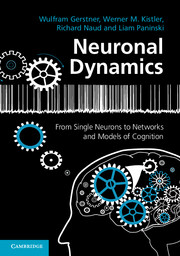Book contents
- Frontmatter
- Contents
- Preface
- PART ONE FOUNDATIONS OF NEURONAL DYNAMICS
- PART TWO GENERALIZED INTEGRATE-AND-FIRE NEURONS
- 5 Nonlinear integrate-and-fire models
- 6 Adaptation and firing patterns
- 7 Variability of spike trains and neural codes
- 8 Noisy input models: barrage of spike arrivals
- 9 Noisy output: escape rate and soft threshold
- 10 Estimating parameters of probabilistic neuron models
- 11 Encoding and decoding with stochastic neuron models
- PART THREE NETWORKS OF NEURONS AND POPULATION ACTIVITY
- PART FOUR DYNAMICS OF COGNITION
- References
- Index
5 - Nonlinear integrate-and-fire models
Published online by Cambridge University Press: 05 August 2014
- Frontmatter
- Contents
- Preface
- PART ONE FOUNDATIONS OF NEURONAL DYNAMICS
- PART TWO GENERALIZED INTEGRATE-AND-FIRE NEURONS
- 5 Nonlinear integrate-and-fire models
- 6 Adaptation and firing patterns
- 7 Variability of spike trains and neural codes
- 8 Noisy input models: barrage of spike arrivals
- 9 Noisy output: escape rate and soft threshold
- 10 Estimating parameters of probabilistic neuron models
- 11 Encoding and decoding with stochastic neuron models
- PART THREE NETWORKS OF NEURONS AND POPULATION ACTIVITY
- PART FOUR DYNAMICS OF COGNITION
- References
- Index
Summary
Detailed conductance-based neuron models can reproduce electrophysiological measurements to a high degree of accuracy, but because of their intrinsic complexity these models are difficult to analyze. For this reason, simple phenomenological spiking neuron models are highly popular for studies of neural coding, memory, and network dynamics. In this chapter we discuss formal threshold models of neuronal firing, also called integrate-andfire models.
The shape of the action potential of a given neuron is rather stereotyped with very little change between one spike and the next. Thus, the shape of the action potential which travels along the axon to a postsynaptic neuron cannot be used to transmit information; rather, from the point of view of the receiving neuron, action potentials are “events” which are fully characterized by the arrival time of the spike at the synapse. Note that spikes from different neuron types can have different shapes and the duration and shape of the spike does influence neurotransmitter release; but the spikes that arrive at a given synapse all come from the same presynaptic neuron and – if we neglect effects of fatigue of ionic channels in the axon – we can assume that its time course is always the same. Therefore we make no effort to model the exact shape of an action potential. Rather, spikes are treated as events characterized by their firing time – and the task consists in finding a model so as to reliably predict spike timings.
- Type
- Chapter
- Information
- Neuronal DynamicsFrom Single Neurons to Networks and Models of Cognition, pp. 119 - 135Publisher: Cambridge University PressPrint publication year: 2014
- 1
- Cited by

